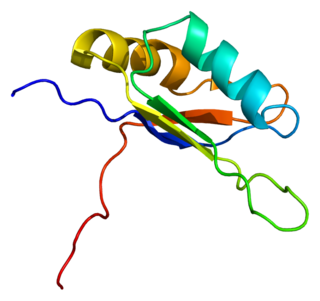Cross-linking and immunoprecipitation is a method used in molecular biology that combines UV crosslinking with immunoprecipitation in order to identify RNA binding sites of proteins on a transcriptome-wide scale, thereby increasing our understanding of post-transcriptional regulatory networks. CLIP can be used either with antibodies against endogenous proteins, or with common peptide tags or affinity purification, which enables the possibility of profiling model organisms or RBPs otherwise lacking suitable antibodies.

TIA1 or Tia1 cytotoxic granule-associated rna binding protein is a 3'UTR mRNA binding protein that can bind the 5'TOP sequence of 5'TOP mRNAs. It is associated with programmed cell death (apoptosis) and regulates alternative splicing of the gene encoding the Fas receptor, an apoptosis-promoting protein. Under stress conditions, TIA1 localizes to cellular RNA-protein conglomerations called stress granules. It is encoded by the TIA1 gene.

Heterogeneous nuclear ribonucleoprotein K is a protein that in humans is encoded by the HNRNPK gene. It is found in the cell nucleus that binds to pre-messenger RNA (mRNA) as a component of heterogeneous ribonucleoprotein particles. The simian homolog is known as protein H16. Both proteins bind to single-stranded DNA as well as to RNA and can stimulate the activity of RNA polymerase II, the protein responsible for most gene transcription. The relative affinities of the proteins for DNA and RNA vary with solution conditions and are inversely correlated, so that conditions promoting strong DNA binding result in weak RNA binding.

Non-POU domain-containing octamer-binding protein (NonO) is a protein that in humans is encoded by the NONO gene.

Melanotransferrin is a protein that in humans is encoded by the MFI2 gene. MFI2 has also recently been designated CD228.

Y box binding protein 1 also known as Y-box transcription factor or nuclease-sensitive element-binding protein 1 is a protein that in humans is encoded by the YBX1 gene.

Nucleolysin TIAR is a protein that in humans is encoded by the TIAL1 gene.

HuD otherwise known as ELAV-like protein 4 is a protein that in humans is encoded by the ELAVL4 gene.

Splicing factor, arginine/serine-rich 9, also known as SFRS9, is a human gene encoding an SR protein involved in splice site selection in alternative splicing.

The serine/threonine-protein kinase/endoribonuclease inositol-requiring enzyme 1 α (IRE1α) is an enzyme that in humans is encoded by the ERN1 gene.

Heterogeneous nuclear ribonucleoprotein L is a protein that in humans is encoded by the HNRNPL gene.

Interleukin-18-binding protein is a protein that in humans is encoded by the IL18BP gene.

U2 small nuclear ribonucleoprotein B is a protein that in humans is encoded by the SNRPB2 gene.

Quaking homolog, KH domain RNA binding (mouse), also known as QKI, is a protein which in humans is encoded by the QKI gene.

Cerebellar degeneration-related protein 2 is a protein that in humans is encoded by the CDR2 gene.

Heat shock factor protein 4 is a protein that in humans is encoded by the HSF4 gene.

AP-3 complex subunit beta-2 is a protein that in humans is encoded by the AP3B2 gene.

U2 small nuclear ribonucleoprotein auxiliary factor 35 kDa subunit-related protein 2 is a protein that in humans is encoded by the ZRSR2 gene.

ELAV-like protein 3 is a protein that in humans is encoded by the ELAVL3 gene.

Robert Bernard Darnell is an American neurooncologist and neuroscientist, founding director and former CEO of the New York Genome Center, the Robert and Harriet Heilbrunn Professor of Cancer Biology at The Rockefeller University, and an Investigator of the Howard Hughes Medical Institute. His research into rare autoimmune brain diseases led to the invention of the HITS-CLIP method to study RNA regulation, and he is developing ways to explore the regulatory portions—known as the "dark matter"—of the human genome.




























